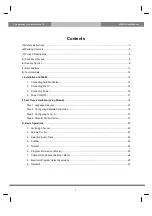
59
Basic playback
05
Category
Extension
Stream
WMA
.wma
WMA2/7/8/9
<d>
Sampling frequency
32 kHz, 44.1 kHz, 48 kHz
Quantization bitrate
16 bit
Channel
2 ch
Bitrate
5 kbps to 320 kbps
VBR/CBR
Supported/Supported
AAC
.m4a
.aac
.3gp
.3g2
MPEG-4 AAC LC
MPEG-4 HE AAC
Sampling frequency
32 kHz, 44.1 kHz, 48 kHz
Quantization bitrate
16 bit
Channel
2 ch
Bitrate
16 kbps to 320 kbps
VBR/CBR
Supported/Supported
Apple Lossless
.m4a
.mp4
Apple Lossless
Sampling frequency
32 kHz, 44.1 kHz, 48 kHz,
88.2 kHz, 96 kHz
Quantization bitrate
16 bit, 24 bit
Channel
2 ch
FLAC
<e>
.flac
FLAC
Sampling frequency
<b>
32 kHz, 44.1 kHz, 48 kHz,
88.2 kHz, 96 kHz, 176.4 kHz,
192 kHz
Quantization bitrate
16 bit, 24 bit
Channel
2 ch, 5.0 ch, 5.1 ch
<c>
AIFF
.aiff
.aif
AIFF
Sampling frequency
32 kHz, 44.1 kHz, 48 kHz,
88.2 kHz, 96 kHz, 176.4 kHz,
192 kHz
Quantization bitrate
16 bit, 24 bit
Channel
2 ch
DSD
<f>
.dff
.dsf
DSDIFF
DSF
Sampling frequency
2.8224 MHz, 5.6448 MHz
Quantization bitrate
1 bit
Channel
2 ch
a
“MPEG Layer-3 audio decoding technology licensed from Fraunhofer IIS and Thomson multimedia.”
b 32 kHz, 176.4 kHz and 192 kHz support 2-channel audio sources only.
c Gapless playback is not possible with a 5.0-channel or 5.1-channel audio source.
d Files encoded using Windows Media Codec 9 may be playable but some parts of the specification are not supported; specifi-
cally, Pro, Lossless, Voice.
e Uncompressed FLAC files are not supported. Pioneer does not guarantee playback.
f DSD files cannot be played in the sub zone.
Photo files
Category
Extension
Format
JPEG
.jpg
Meeting the following conditions:
!
Baseline JPEG format
!
Y:Cb:Cr – 4:2:2
Playing an MHL-compatible device
MHL (Mobile High-definition Link) is an interface standard for transmitting digital signals with mobile devices.
MHL can carry high quality multi-channel audio data and 3D/Full-HD video formats.
The MHL-compatible device’s video signals are output from the TV connected to the receiver, the audio signals
are output from the speakers connected to the receiver or TV.
1 Press
u
STANDBY/ON to switch on the receiver and your TV.
Connecting an MHL-compatible device
2 Press MHL on the remote control to switch the receiver to the MHL.
3 Select and play the desired contents on the MHL-compatible device.
Notes
!
MHL-compatible devices can be operated with the receiver’s remote control by pressing the remote control’s
MHL
button, but depending on the MHL-compatible device being used, some buttons may not be operable.
!
To playback from a MHL-compatible device connected to the receiver on a TV that is also connected to the
receiver, the power to the receiver must be turned on.
Playing music from a computer
SC-LX88 only
Use this function to play digital audio input to the unit’s rear panel
USB-DAC IN
terminal.
Important
!
When switching this unit’s input from
USB-DAC
to another input, first quit the computer’s music playback
application, then switch the input.
!
The exclusive driver must be installed on the computer in order to play high sound quality files of over
48 kHz/24 bits and DSD files.
The driver software is provided on the included CD-ROM.
1 Press
u
STANDBY/ON to switch on the receiver and your computer.
Using a USB cable to connect to a computer
.
2 Use ALL
to select USB-DAC.
You can also use the
INPUT SELECTOR
dial on the front panel.
3 Begin playback on the computer.
Notes
!
Output from the
OPTICAL OUT
terminal is not supported during
USB-DAC IN
input.
!
In addition to LPCM, DSD with DoP transmission is also supported. The supported format is 2.8 MHz, 1 bit.
Only two channels, including LPCM, are supported.
!
Playback cannot be controlled from this unit during use of this function; use your computer to control
playback.
!
When disconnecting the USB cable, always stop playback on the computer first.
!
Sound may not be produced if your computer does not support USB 2.0 HS.
!
This unit does not support use of a USB hub. Always use a USB cable to connect the unit directly to the
computer.
















































